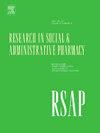获得药品是否与获得医疗保健不同?面临社会不利地位的人获得药物的障碍的经验。
IF 3.7
3区 医学
Q1 PUBLIC, ENVIRONMENTAL & OCCUPATIONAL HEALTH
Research in Social & Administrative Pharmacy
Pub Date : 2025-02-27
DOI:10.1016/j.sapharm.2025.02.010
引用次数: 0
摘要
背景:Levesque等人广泛引用的获得医疗保健的五维模型已在各种情况下使用,包括获得药物。然而,该模型基于医疗保健,即卫生专业人员工作的设施。我们研究了是否还有其他重要的药物获取特征没有被这个模型所包含。方法:进行纵向定性研究,在一年的时间里反复采访21个家庭,了解他们的生活和获得药物的情况。参与者为Māori、太平洋地区、前难民或收入有限的新西兰欧洲人。分析是主题和归纳。结果:我们的参与者在获得药物方面遇到了一些障碍,其中一些障碍不适合现有的获得医疗保健的模式。例如,与医护人员的沟通困难(缺乏适当的护理)对参与者回家后的服药有影响。对药物的特性、用途和可能的副作用的混淆导致难以获得或使用不足的处方药。前难民参加者的通讯问题特别严重。对他们来说,在药房沟通是不可能的,因为缺乏口译员,严重限制了他们获得的信息,并增加了使用其他不太可靠的信息来源。犯罪、对犯罪的恐惧和司法系统也以各种方式影响着获取。结论:由于药品是可携带的、可随身携带的物品,医疗保健的适宜性在家中发挥作用。更广泛的非卫生保健环境的各个方面也以意想不到的方式影响药品的获取。本文章由计算机程序翻译,如有差异,请以英文原文为准。
Does access to medicines differ from access to healthcare? Experiences of barriers to medicines access by people facing social disadvantage
Background
Levesque et al.’s widely-cited five dimensional model of access to healthcare has been used in a variety of contexts, including access to medicines. However the model is based on healthcare, i.e., facilities where health professionals work. We examined whether there were other important features of access to medicines, not captured by this model.
Methods
A longitudinal qualitative study was conducted, repeatedly interviewing 21 households about their lives and access to medicines, over the course of a year. Participants were Māori, Pacific, former refugee, or New Zealand Europeans with limited incomes. Analysis was thematic and inductive.
Results
Our participants experienced a number of barriers to accessing medicine, some of which do not fit comfortably within existing models of access to healthcare. For example, communication difficulties with healthcare staff (lack of appropriateness of care), had implications for medicine-taking after participants got home. Confusion about medicines identity, purpose and possible side effects, led to poorer access or under-use of prescribed medicines. Communication problems were particularly acute for former refugee participants. For them, communication in pharmacies was impossible because of lack of interpreters, severely restricting the information they had access to, and increasing the use of other less reliable sources of information. Crime, fear of crime, and the justice system also impacted on access in a variety of ways.
Conclusion
Because medicines are portable, physical objects taken at home, the effects of appropriateness of healthcare are played out in the home. Aspects of the wider, non-healthcare environment also impact on access to medicines in unexpected ways.
求助全文
通过发布文献求助,成功后即可免费获取论文全文。
去求助
来源期刊

Research in Social & Administrative Pharmacy
PUBLIC, ENVIRONMENTAL & OCCUPATIONAL HEALTH-
CiteScore
7.20
自引率
10.30%
发文量
225
审稿时长
47 days
期刊介绍:
Research in Social and Administrative Pharmacy (RSAP) is a quarterly publication featuring original scientific reports and comprehensive review articles in the social and administrative pharmaceutical sciences. Topics of interest include outcomes evaluation of products, programs, or services; pharmacoepidemiology; medication adherence; direct-to-consumer advertising of prescription medications; disease state management; health systems reform; drug marketing; medication distribution systems such as e-prescribing; web-based pharmaceutical/medical services; drug commerce and re-importation; and health professions workforce issues.
 求助内容:
求助内容: 应助结果提醒方式:
应助结果提醒方式:


